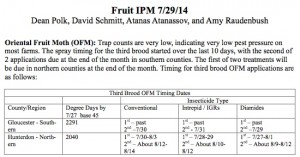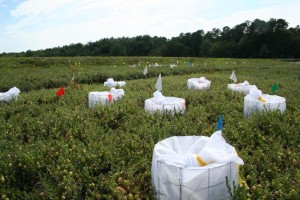This week in Fruit IPM
- Tree Fruit
- Grape
- Blueberry
Fruit Crops Edition
Seasonal updates on diseases, insects, weeds impacting tree fruit and small fruit (blueberry, cranberry, and wine grape). Fruit Pest Alerts are also available via this category feed.
Subscriptions are available via EMAIL and RSS.
Fruit IPM Report August 15, 2014
American Cranberry Growers Association 2014 Summer Field Day
The American Cranberry Growers Association 2014 Summer Field Day will be held on Friday August 22, 2014 at the P.E. Marucci Center for Blueberry & Cranberry Research & Extension in Chatsworth, NJ.
Click to View | Download Flyer
Meeting Agenda
Fruit IPM Report August 7, 2014
This week in Fruit IPM
Spotted Wing Drosophila counts increase,
but are at low levels compared to 2013.
- Tree Fruit
- Section 18 Labels
Brigade
Scorpion
Bifenture.10DF
Bifenture.EC
Venom- Grape
- Blueberry
Proposed Importation of Apples from China
A proposed rule is open for public comment that would allow the importation of apples into US markets from China.
A pest risk assessment has identified 21 pests that are on US quarantine lists which could be introduced in/on apples from China. Assurances have been made that fruit will be inspected prior to harvest for signs of infestation and fumigated prior to entrance into the US. However, the importation of fruit increases the likelihood that pests, such as the Oriental Fruit Fly, the plum fruit moth and the summer fruit tortrix, could be accidentally introduced and become established.
You may submit comments electronically by visiting http://www.regulations.gov/#!docketDetail;D=APHIS-2014-0003
Beating the Bugs in the Bogs – Sparganothis Fruitworm and Spotted Fireworm
Sparganothis fruitworm and spotted fireworm are important pests of cranberries; therefore, plant resistance against these insects is a major topic of study.
Both insects feed on cranberry uprights and developing fruit during the summer. Dr. Elvira de Lange, a postdoc at the Blueberry and Cranberry Research Center, is especially interested in the resistance factors against these insects that are naturally present in cranberry fruits.
[Read more…]



